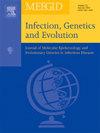A potential bimodal interplay between heme and complement factor H 402H in the deregulation of the complement alternative pathway by SARS-CoV-2
IF 2.6
4区 医学
Q3 INFECTIOUS DISEASES
引用次数: 0
Abstract
The recent discovery that the trimeric SARS-CoV-2 spike S glycoprotein carries heme within an NTD domain pocket of the S1 subunits, suggested that this virus may be cleverly utilizing heme, in addition to the S1 RBD domains, for invading target cells carrying a specific entry receptor like ACE2, TMEM106B and others. Studies during the COVID-19 pandemic revealed that the infectivity of this virus depends on cell surface heparan sulfate and that the infection induces non-canonical activation of the Complement Alternative pathway (AP) on the surface of infected cells.
In our recent COVID-19 genomic studies, among the coding SNPs of interest we also detected the presence of the CFH rs1061170, rs800292 and rs1065489 within all the infected patient subgroups examined. The minor C allele of rs1061170 encodes CFH 402H that over the years has been associated with diseases characterized by complement dysregulation namely the age-related macular degeneration (AMD) and the atypical haemolytic uremic syndrome (aHUS). Also, more recently with the diminishment of CD4+ T cell responses with ageing. The rs800292 minor allele A encodes CFH 62I that supports enhanced cofactor activity for Complement factor I (CFI). Also, the rs1065489 minor allele T encodes CFH 936D and is located within the CCP16 domain that influences the affinity of CFH with extracellular laminins.
A subsequent computational analysis revealed that the CFH residue 402 is located centrally within a heme-binding motif (HBM) in domain CCP7 (398YNQNYGRKF406). Heme on the viral spike glycoprotein S1 subunit could recruit CFH 402H for masking free viral particles from opsonisation, and when in proximity to cell surface, act as a bait disrupting CFH 402H from the heparan sulphate coat of the target cells. Publicly available genetic data for European populations indicate that the minor C allele of rs1061170 is present only in haplotypes that carry the major alleles of rs800292 and rs1065489. This combination encodes for CFH 402H that exhibits increased biochemical affinity for heme in proximity, without enhanced cofactor activity for CFI and weaker association with the extracellular matrix. In the theatre of infection, this combination can promote heme-mediated viral infection with weaker complement opsonisation and potential AP deregulation. This strategy may be evolutionary conserved among various classes of infectious agents.
血红素和补体因子h402h之间的潜在双峰相互作用在SARS-CoV-2对补体替代途径的解除管制中
最近发现,三聚体SARS-CoV-2刺突S糖蛋白在S1亚基的NTD结构域口袋内携带血红素,这表明这种病毒可能巧妙地利用血红素,除了S1 RBD结构域外,入侵携带特定进入受体的靶细胞,如ACE2, TMEM106B等。在COVID-19大流行期间的研究表明,该病毒的传染性依赖于细胞表面硫酸肝素,并且感染诱导受感染细胞表面补体替代途径(AP)的非典型激活。在我们最近的COVID-19基因组研究中,在感兴趣的编码snp中,我们还在所有检查的感染患者亚组中检测到CFH rs1061170, rs800292和rs1065489的存在。rs1061170的小C等位基因编码CFH 402H,多年来,CFH 402H与补体失调相关的疾病,即年龄相关性黄斑变性(AMD)和非典型溶血性尿毒症综合征(aHUS)。此外,随着年龄的增长,CD4+ T细胞的反应也在减少。rs800292次要等位基因A编码CFH 62I,支持补体因子I (CFI)的增强辅因子活性。此外,rs1065489小等位基因T编码CFH 936D,位于影响CFH与细胞外层合蛋白亲和力的CCP16结构域内。随后的计算分析显示,CFH残基402位于CCP7结构域(398YNQNYGRKF406)的一个血红素结合基元(HBM)的中心位置。病毒刺突糖蛋白S1亚基上的血红素可以招募CFH 402H来掩盖游离病毒颗粒的活化,当靠近细胞表面时,作为诱饵破坏靶细胞硫酸肝素外壳上的CFH 402H。公开获得的欧洲人群遗传数据表明,rs1061170的次要C等位基因只存在于携带rs800292和rs1065489的主要等位基因的单倍型中。该组合编码CFH 402H,该CFH 402H对血红素具有增强的生化亲和力,而对CFI没有增强的辅助因子活性,与细胞外基质的关联较弱。在感染阶段,这种组合可以促进血红素介导的病毒感染,并减弱补体调理和潜在的AP解除管制。这种策略可能在不同类型的感染因子中具有进化保守性。
本文章由计算机程序翻译,如有差异,请以英文原文为准。
求助全文
约1分钟内获得全文
求助全文
来源期刊

Infection Genetics and Evolution
医学-传染病学
CiteScore
8.40
自引率
0.00%
发文量
215
审稿时长
82 days
期刊介绍:
(aka Journal of Molecular Epidemiology and Evolutionary Genetics of Infectious Diseases -- MEEGID)
Infectious diseases constitute one of the main challenges to medical science in the coming century. The impressive development of molecular megatechnologies and of bioinformatics have greatly increased our knowledge of the evolution, transmission and pathogenicity of infectious diseases. Research has shown that host susceptibility to many infectious diseases has a genetic basis. Furthermore, much is now known on the molecular epidemiology, evolution and virulence of pathogenic agents, as well as their resistance to drugs, vaccines, and antibiotics. Equally, research on the genetics of disease vectors has greatly improved our understanding of their systematics, has increased our capacity to identify target populations for control or intervention, and has provided detailed information on the mechanisms of insecticide resistance.
However, the genetics and evolutionary biology of hosts, pathogens and vectors have tended to develop as three separate fields of research. This artificial compartmentalisation is of concern due to our growing appreciation of the strong co-evolutionary interactions among hosts, pathogens and vectors.
Infection, Genetics and Evolution and its companion congress [MEEGID](http://www.meegidconference.com/) (for Molecular Epidemiology and Evolutionary Genetics of Infectious Diseases) are the main forum acting for the cross-fertilization between evolutionary science and biomedical research on infectious diseases.
Infection, Genetics and Evolution is the only journal that welcomes articles dealing with the genetics and evolutionary biology of hosts, pathogens and vectors, and coevolution processes among them in relation to infection and disease manifestation. All infectious models enter the scope of the journal, including pathogens of humans, animals and plants, either parasites, fungi, bacteria, viruses or prions. The journal welcomes articles dealing with genetics, population genetics, genomics, postgenomics, gene expression, evolutionary biology, population dynamics, mathematical modeling and bioinformatics. We also provide many author benefits, such as free PDFs, a liberal copyright policy, special discounts on Elsevier publications and much more. Please click here for more information on our author services .
 求助内容:
求助内容: 应助结果提醒方式:
应助结果提醒方式:


